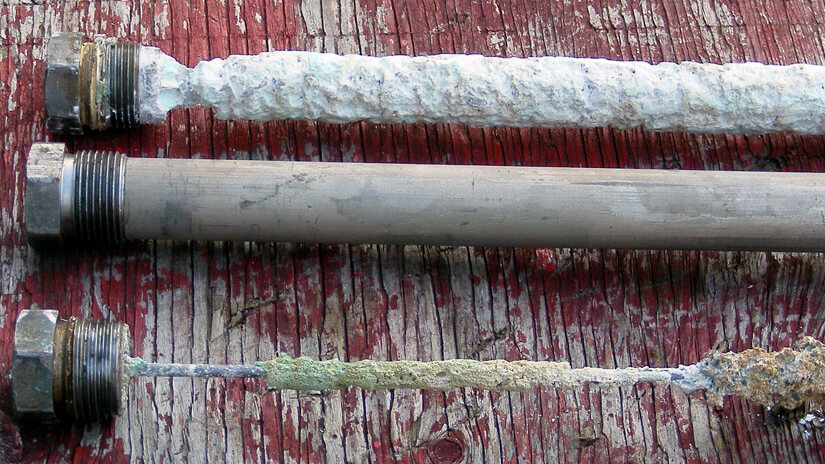What is an anode in a hot water heater?
An anode rod, often called a sacrificial anode, is key in safeguarding your hot water tank against rust. These rods play an essential role in prolonging the life of your hot water system.
A sacrificial anode is a steel rod surrounded by magnesium, aluminium or zinc and is located on the top of water heaters. It works through a process called electrolysis.

The sacrificial anode will corrode instead of the water heater steel, saving the hot water system from creating rusty water and bursting. Hot water tanks made from stainless steel do not corrode and, therefore, do not have an anode rod.
Need a Plumbing Service?
How often should you replace the anode rod in a water heater?
Many folks might not realize that a water heater anode needs regular replacement. While your tank might still supply hot water consistently, it’s vital to know what’s happening behind the scenes inside the unit.
Your hot water system—be it electric, gas, or solar—usually lasts about 10 to 12 years, depending on how well it’s been maintained. Learn more about its lifespan here.
Leaks, temperature issues, and water pressure changes can occur occasionally. However, regularly inspecting and replacing your anode rod can boost your tank’s durability and lifespan. It’s a good idea to change the anode rod every 3 to 4 years.
You might consider removing the anode if:
- It’s been over three years since you last changed it
- Your hot water tank makes popping noises when heating
- You’re looking to extend the lifespan of your tank
- You’re noticing smelly water
- Your water bill is unexpectedly high
How do you change an anode rod in a hot water heater?
You will need a replacement sacrificial anode, a bucket, and an impact socket. Make sure you have these materials ready.
Step 1: Turn off the power supply to your water heater at the circuit breaker. If yours is powered by gas, you must also shut off the gas supply. Then, turn off the cold water supply on the unit’s side or top to let the tank fill. Switch on a hot water tap or faucet to relieve the tank pressure.
Step 2: Drain the tank water by opening the drain and hot water valve. You can partially drain about 10% of the water supply in the tank. Have your bucket or garden hose handy to divert the water outside. Attach your hose to the boiler drain, which you can find at the bottom of the tank.
Step 3: Find the anode or sacrificial rod. You may have to remove the top lid or remove the plastic cap and look inside the heater.
Step 4: Removing the rod may prove difficult. Getting help from another person may be beneficial. Loosen the hex head bolt with a large and durable socket wrench. Once the bolt is loosened, you can remove the anode rod. Be careful, for this action might cause broken pipes or leaks.
Step 5: Install your new anode rod. You can use a plumber’s tape (Teflon Tape) to wrap around the joint threads. Use your socket wrench to tighten (not over-tighten) the rod into the opening. It would help to tighten it by hand, and then the wrench would be used at 180 degrees to finish it. Then, turn on the power for your hot water and cold water supply.
Need a Plumbing Service?
When it comes to hot water systems, it’s often best to reach out to a licensed plumber like Fixed Today Plumbing for a checkup on your water heater and sacrificial anodes. We have the right tools and expertise to properly remove and replace your water heater’s anode rod.














